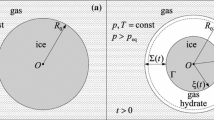Abstract
A mathematical model of the interface charging at evaporation and growth of ice and water phases from vapor is proposed. This model takes into account the competition between the two mechanisms of charge separation, one of which is based on protons and the other involves orientational defects. The first mechanism leads to the accumulation of a positive charge by ice and water during evaporation, while the second one provides negative charge accumulation. The protonic mechanism dominates at low velocities of the evaporation front with respect to the condensed phase material (lower than 10−11–10−9 m/s). At high rates, the mechanism based on orientational defects is dominant. When vapor is condensed, and, correspondingly, the ice and water phases grow, the charge polarity is opposite to the polarity in the case of evaporation. The proposed model adequately describes the experimentally observed interface electric current and the signs of phase charges during evaporation and condensation.
Similar content being viewed by others
References
T. Cavallo, Trattato completo d’lettricita teorica e pratica con sperimenti originali del Signore Tiberio Cavallo. Tradotto in italiano dall’originale inglese. Con addizioni e cangiamenti fatti dall’autore (Gaetano Cambiagi, Firenze, 1779), p. 8.
B. Khasanov and Ya. Shneĭberg, Connect! Mir Svyazi, No. 9, 25 (2001).
W. Findeisen, Meteorol. Z, No. 6, 201 (1940).
T. Takahashi, J. Atmos. Sci., 30, 1220 (1973).
B. Baker, M. B. Baker, E. R. Jayarante, et al., Q.J.R. Meteorol. Soc. 113, 1193 (1987).
Y. Dong and J. Hallett, J. Geophys. Res. D 97(18), 20361 (1992).
Ya. I. Frenkel’, Izv. Akad. Nauk SSSR, Ser. Geogr. Geofiz. 8, 244 (1944).
A. P. Babichev, N. A. Babushkina, A. M. Bratkovskiĭ, et al., in Physical Values: A Handbook, Ed. by I. S. Grigor’ev and E. Z. Meĭlikhov (Energoatomizdat, Moscow, 1991).
N. Maeno, The Sciency of Ice (Hokkaido Univ. Press, Sapporo, 1984; Mir, Moscow, 1988).
A. V. Shavlov, Ice in Structural Transformations (Nauka, Novosibirsk, 1996) [in Russian].
A. V. Shavlov, Kristallografiya 50(5), 947 (2005).
B. Yudaev, Technical Thermodynamics: Heat Transfer (Vysshaya shkola, Moscow, 1988) [in Russian].
F. Crate and W. Black, Fundamentals of Heat Transfer (Mir, Moscow, 1983) [in Russian].
S. M. Shmeter, Physics of Condensed Clouds (Gidrometeoizdat, Leningrad, 1972) [in Russian].
M. Ya. Balbachan, Dokl. Akad. Nauk SSSR 316(6), 1358 (1991).
Author information
Authors and Affiliations
Corresponding author
Additional information
Original Russian Text © A.V. Shavlov, 2008, published in Kristallografiya, 2008, Vol. 53, No. 6, pp. 1138–1144.



